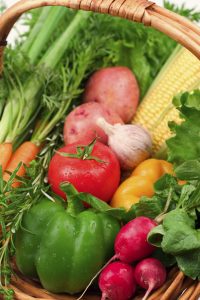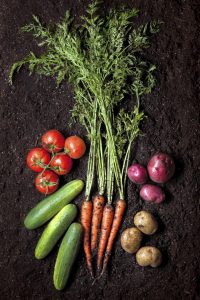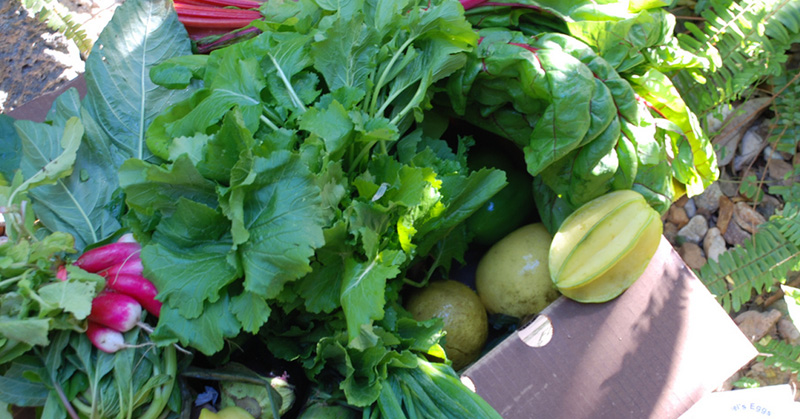As we step even deeper into spring, it’s that time of year where eating seasonally is easier than ever regardless of where you live. Farmers markets are starting to open and those early greens and berries are popping up on grocery store shelves.
Psst . . . Before we jump into the local food conversation, I just want to make sure you’re RSVP’d for our virtual book tour! It’s happening tomorrow, Wednesday May 9th at 6pm EST/3pm PST and we’d LOVE to have you there. It’s totally free and you can join from anywhere. All you need is your computer and an internet connection. We’ll be talking Naked cooking and are happy to answer all your questions. See you there! RSVP now.
This week, I want to introduce you to a concept you may or may not be familiar with: the CSA, or “Community Supported Agriculture.” A CSA is a great way to build a deep relationship with a local farmer and to ensure you’re eating seasonally and locally all summer long. It’s a step further than buying direct from the farmer. In a CSA you invest in the farm by purchasing a share at the outset of the season. This helps the farmer offset her costs while guaranteeing a market for her yield. In return for your investment, you get delicious, local, seasonal produce delivered on a regular basis throughout the season based on the farm’s yields. Talk about bridging the gap from farmer to eater!
Choosing the CSA that’s right for you is an art in and of itself, and can be a little overwhelming for the newbie. Luckily our friends at Farmplate have put together a guide for key considerations and have a tool to help you find a CSA near you. Enjoy today’s guest post written by Anna Villarruel, a senior at Dartmouth College and an Editorial Intern at Farmplate.com.
Eat Fresh, Eat Local: How to Choose A CSA
 According to the USDA, CSAs, farmers’ markets, and other direct farm-to-consumer sales are spreading like wildfire. And now is the time of year when farms are signing up people to participate. For the uninitiated, CSA stands for “Community Supported Agriculture,” where customers essentially pay up front for a share of a given farm’s annual produce.
According to the USDA, CSAs, farmers’ markets, and other direct farm-to-consumer sales are spreading like wildfire. And now is the time of year when farms are signing up people to participate. For the uninitiated, CSA stands for “Community Supported Agriculture,” where customers essentially pay up front for a share of a given farm’s annual produce.
It’s important to do your research before signing on to a CSA, so here are some things to consider:
Variations on the CSA Theme
Some CSAs are tied directly to the farm, but others are run more like buying clubs where the CSA organizers buy from a number of different farmers, and you may be able to get fruit, meat, cheese and even fibers, like wool, in addition to vegetables. Some of these programs have a huge geographic range, which can be convenient if you want berries in the off season, but not all of the offerings always fit into a localvore’s diet.
Then there are Shareholder CSAs, Pick-Your-Own options and CSA workshares. Make sure you understand their policies so you don’t overcommit without knowing it!
Increasingly, CSAs aren’t confined to produce. Some non-farming options include community supported baking, fishing, edible gardening, food production and cooking, food retailers, restaurants, and even foraging. (Click on the links above for definitions from the FarmPlate glossary.)
Produce Selection
Each CSA farm grows a different mix of produce. Some focus on a small number of more popular items, while others provide a wider range of produce. To figure out which farm is best for you, think about what you like to eat. Many farms have a list of what they grow on their websites, and some even include recipes with your share. No matter how cheap the produce or how convenient the drop-off site, you don’t want a box of produce rotting in your fridge each week! CSAs often allow you to be creative and try new varieties of produce, which is part of the fun.
 Share Size & Price
Share Size & Price
CSA farm shares vary quite a bit in price. Some are upwards of $500 while many are quite a bit less, especially if you have the option to purchase a half-size share. Do the math and figure out the per-week costs. How many people are you feeding? How often do you cook? What do you like to cook? And how does it compare to your grocery bill?
Talk to the farmer about how much food is included on a given week if you’re not sure, and ask if there are any changes throughout the season that you should be aware of (when kale season comes, will your refrigerator be full of the stuff?). You should always feel like you’re getting a good value.
Tip: If a farm only offers whole shares, split yours with a friend!
Convenience
Pick-up/delivery days and times vary by CSA farm. Think about how far you would be willing to travel on a weekly basis to get your share and what pick-up option would be most convenient and enjoyable for you. Choose the option that best fits your life as you live it. Convenience (or lack thereof) will have a huge impact on your experience throughout the entire CSA season.
Another thing to consider is how much time you want to spend on the farm. Some CSA farms offer a variety of ways to keep in touch with farmers through on-farm activities, newsletters and interactions during pick-up. If seeing the farm and participating in farm activities is important to you, then choose one that is close to your home; the likelihood of you actually making it to the farm is far greater when it’s nearby.
Whatever you do, find a way to get some local produce into your house this summer, whether from a CSA, farmers’ market, farm stand or grocery store. Your diet, your dinner and your community will be all the better for it! USE FARMPLATE TO FIND A GREAT CSA NEAR YOU >



